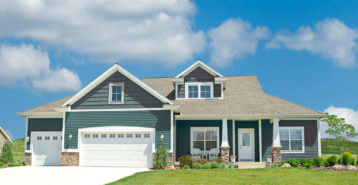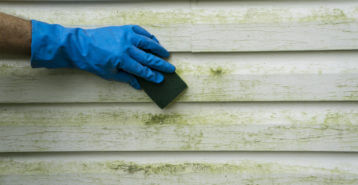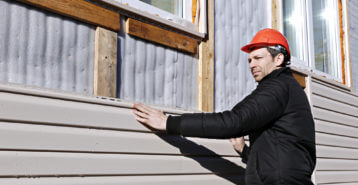- How Much Does Home Siding Cost?
- Home Siding Cost Calculator
- How Much Does Vinyl Siding Cost?
- Home Siding Cost by Material Type
- Home Siding Cost by House Size
- How to Estimate Your Total Siding Costs
- Is New House Siding a Good Investment?
- How to Find a Siding Replacement Professional
- Frequently Asked Questions
How Much Does Home Siding Replacement Cost in 2026?
You can expect to pay $17,200 for mid-range siding for a 2,000 square foot house, or $8.60 per square foot installed. This project estimate falls toward the higher end of the national average house siding cost range of $2,560 to $20,400. To reach this average estimate, we looked at cost ranges for five siding types (vinyl, metal, wood, fiber cement, and stucco) as well as how much each material costs to install. Then, we averaged them together to reach the price per square foot above. For a more accurate estimate, use our home siding cost calculator above.
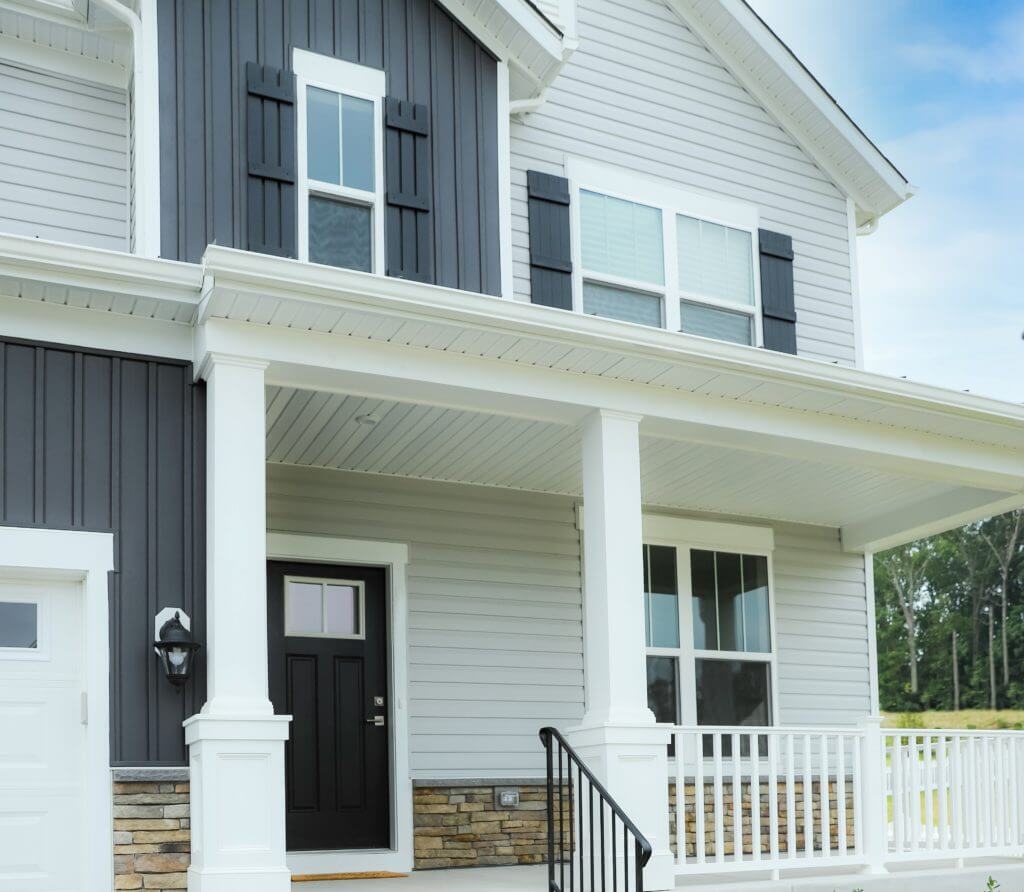
Factors That Affect Your Siding Replacement Costs
The national average cost for new house siding depends on several factors:
- Home Size: Larger homes need more siding.
- Location: Material transport and labor rates vary by city.
- Siding Material: Vinyl starts at $3 per square foot, but options like metal or fiber cement can cost nearly double.
- Full vs Partial Replacement: Replacing only damaged areas costs less than full siding replacement.
- Installation Complexity: Removing old siding, multi-story homes, or hidden damage all affect the cost. Talk to a contractor for an accurate estimate.
Home Siding Cost Calculator
When you’ve finished using the home siding cost calculator, you can also ask us to match you with contractors in your area so you can start getting quotes.
Now that you know how siding project costs break down and your estimate, let’s look at the average cost range of siding materials.
How Much Does Vinyl Siding Cost?
Vinyl is the least expensive of all types of siding at an average cost of $4.50 to $8.20 per square foot installed. However, the most basic vinyl siding can start at just $3 per square foot, and some high-quality options can cost $12 or more per square foot. Our guide to vinyl siding covers the eight vinyl siding types and how much each cost.
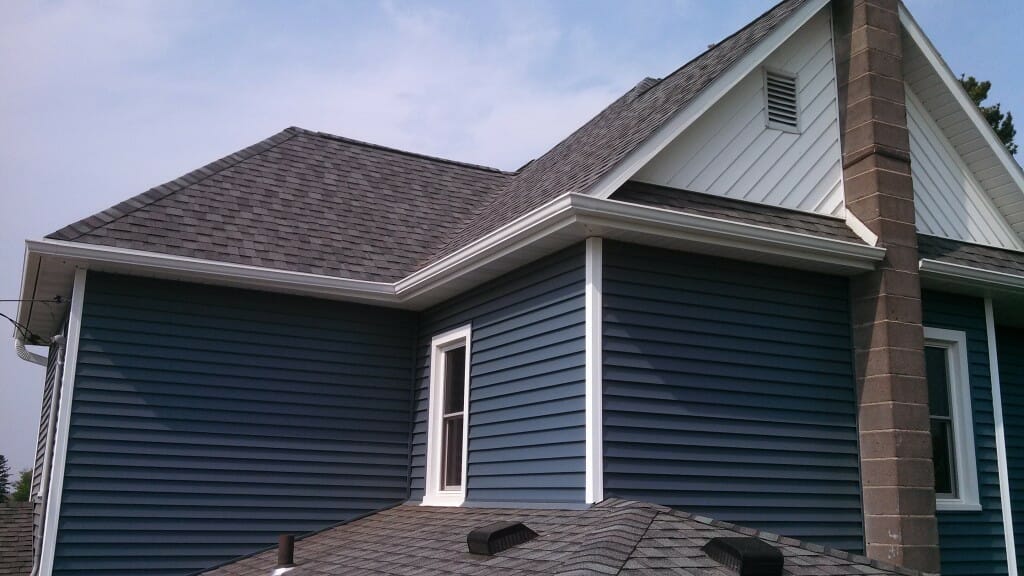
Vinyl siding’s affordability, low maintenance, and durability make it the most popular choice for homeowners in the U.S. However, it’s not ideal for every situation, including:
- Homes in Extreme Temperatures: Vinyl becomes brittle in cold weather and can warp or fade in intense sunlight.
- Wildfire-Prone Areas: Vinyl melts in high heat. Stucco is a better option for fire resistance.
- Environmentally Conscious Homeowners: PVC vinyl has environmental impacts in both production and disposal.
- Homes With Style Requirements: Vinyl may not suit historic homes, HOA guidelines, or high-end custom builds.
Additional Vinyl Siding Costs Table
In addition to materials and labor, there are several smaller expenses that can increase the overall price of your project. The table below provides sample costs for a vinyl siding installation on a home just under 2,000 square feet.
| Siding Installation Line Item | Cost |
|---|---|
| Siding installation permit | $200 |
| Finishing strips | $19.80 (6 strips x $3.30 each) |
| Starter strips | $41.75 (15 strips x $2.75) |
| Hydrants, outlets, vents, including hydrant faucets, gable vents, plug-in outlets, and light fixtures | $300.00 |
| Inside corner | $48.60 (9 pieces x $5.40 per piece) |
| Outside corner | $19.70 (2 pieces x $9.85 per) |
| J-channels | $198.00 ($3.60 x 55) |
| Nails | $40.00 |
| Shutters | $468.00 ($39.00 x 12 pieces) |
| Additional costs | $45.00 delivery charge and $250 garbage rental |
| Old siding removal cost | $1,000 |
| Estimated total cost for siding installation | $15,275.35 |
You may also need to budget for extras such as window trimming, soffits, or fascia boards.
Home Siding Cost by Material Type
The siding type you choose will have a significant impact on your project cost. Below, you’ll find a table of the most common materials, their average cost range per square foot, and their estimated installation cost range for a 2,500-square-foot house.
| Siding Type | Cost Per Square Foot | Installation Cost - 2,500 square feet |
|---|---|---|
| Aluminum | $5.60 - $10.30 | $16,100 - $29,375 |
| Brick Siding | $5 - $15 | $10,000 - $30,000 |
| Fiber Cement | $4.70 - $8.50 | $13,700 - $25,000 |
| Hardie Board | $4.70 - $8.50 | $13,700 - $25,000 |
| Natural Stone | $30 - $48 | $56,000 - 100,000 |
| Stucco Siding | $9.30 - $16.90 | $25,200 - $45,950 |
| Vinyl Siding | $4.50 - $8.20 | $13,325 - $24,300 |
| Wood Siding | $6.90 - $13.90 | $19,300 - $45,175 |
Not sure what type you need? Here’s what to know about each.
- Aluminum: Durable, eco-friendly, and weather-resistant, aluminum siding is a popular, mid-range option. It costs $5.60 to $10.30 per square foot.
- Brick: Brick is one of the most durable siding options, making it an excellent choice if you live in an area with extreme weather. It costs $5 to $15 a square foot.
- Fiber Cement: Fiber cement siding costs $4.70 to $8.50 per square foot, lasts 50 years or more, and unlike vinyl, and is weather- and fire-resistant.
- Hardie Board: Hardie board is a type of fiber cement siding. It falls in the same cost range of $4.70 to $8.50 per square foot and shares all of the fiber cement siding’s benefits. The Hardie Board brand is especially committed to sustainability.
- Natural Stone: Gorgeous, low-maintenance, and durable, natural stone siding is one of the most expensive options at $30 to $48 per square foot. The material’s weight makes it expensive to transport and difficult to install.
- Stucco: Stucco is very popular in the Southwest and Pacific regions since it is fire-resistant, energy-efficient, and low maintenance. It’ll cost you $9.30 to $16.90 per square foot.
- Vinyl: The most popular and versatile siding choice, vinyl is also the most affordable option at $4.50 to $8.20 per square foot.
- Wood: Wood siding is a beautiful, classic choice, but wood is both pricey and high-maintenance. It costs $6.90 to $13.90 per square foot.
Home Siding Cost by House Size
Your home’s square footage is a helpful starting point for estimating how much siding you will need, but it will not provide an exact calculation. The size of your interior living space does not always reflect the full shape and perimeter of your home.
To give you a better idea of how siding needs and overall project costs can vary, the table below shows sample estimates. These figures are based on mid-range siding priced at $8.60 per square foot.
| House Square Footage | One or Two Stories? | House Style | Siding Needed | Est. Cost |
|---|---|---|---|---|
| 1,200 | One | Ranch | 1,400 sq. ft. | $12,040 |
| 1,500 | One | Bungalow | 1,100 sq. ft. | $9,460 |
| 2,000 | Two | Cape Cod | 2,480 sq. ft. | $21,328 |
| 2,500 | Two | Cape Cod | 3,200 sq. ft. | $27,520 |
| 3,000 | Two | Custom | 3,840 sq. ft. | $33,024 |
Let’s break down how we calculated each home’s square footage needs.
How Much Siding Does a 1,200 sq. ft. House Need?
To calculate siding for a 1,200 sq. ft. home, we assumed it’s a one-story ranch-style home. Ranch homes are long and narrow, averaging 22 feet wide and 48 feet long. This 1,200 sq. ft. home would need 1,400 square feet of siding.
How Much Siding Does a 1,500 sq. ft. House Need?
For this 1,500 sq. ft. home, we assumed a single-story bungalow. Bungalows are more square-shaped than ranch homes, averaging 25 feet wide and 30 feet long. This home would need 1,100 square feet of siding, less than the 1,200 sq. ft. due to the perimeter’s shape.
How Much Siding Does a 2,000 sq. ft. House Need?
We assumed a two-story cape-style house. Cape homes typically measure 26 feet wide and 36 feet long, so this 2,000 sq. ft. home would need 2,480 square feet of siding.
How Much Siding Does a 2,500 sq. ft. House Need?
For a two-story, 2,500 sq. ft. home, we used common measurements: 35 feet wide and 45 feet long. This home would need 3,200 square feet of siding.
How Much Siding Does a 3,000 sq. ft. House Need?
For a 3,000 sq. ft. home, we selected dimensions of 38 feet wide and 58 feet long. This home would need 3,840 square feet of siding.
Note that all estimates assume an average height of 10 feet for a one-story house and 20 feet for a two-story house.
A contractor can provide a more accurate estimate. You can also measure your home’s perimeter and use these calculations to get an idea of your project’s needs.
How to Estimate How Many Square Feet of Siding You Need
If you want to get a more accurate estimate of how many square feet of siding you need, calculate total wall lengths multiplied by the height of the house.
For example, take a two-story home that is 25 ft. by 45 ft. and is 20 ft. high.
To do the calculation, total the wall lengths, and then multiply by the home’s height. For our fictional two-story house, the calculation is:
25 ft. + 45 ft. +25 ft. + 45 ft. = 140 ft. of wall length
140 x 20 ft. wall height = 2,800 square feet of siding
The example home on which we’ve based these measurements had a 2,250-square-foot interior. There’s more siding needed than there is interior floor space.
How to Estimate Your Total Siding Costs
If you’d rather estimate on your own instead of using our home siding cost calculator, follow these steps. Estimating siding costs becomes much easier once you know the total square footage of siding your home needs. From there, your overall price will depend on three main factors: the type of siding material you choose, labor rates in your area, and any additional work required such as repairs, insulation, or trim replacement. Most siding contractors quote projects using a “cost per square foot” model, so multiplying your siding square footage by the material’s average installed price will give you a solid starting estimate.
To estimate siding costs, follow this simple approach:
- 1. Determine your siding square footage. Use the calculation above to confirm how much exterior surface area you need to cover.
- 2. Choose your material. Each siding type, such as vinyl, fiber cement, wood, metal, or engineered wood, has its own cost per square foot. Vinyl is typically the most affordable, while fiber cement and wood tend to run higher.
- 3. Multiply material cost by square footage. For example, if vinyl siding averages $6 per square foot installed and your home needs 2,800 sq. ft. of siding, your estimated cost would be about $16,800.
- 4. Add potential extra costs. These can include old siding removal, structural repairs, new house wrap, trim, soffits, or painting. These additional expenses can add a few hundred to several thousand dollars depending on your home’s condition.
This method won’t replace a professional quote, but it gives you a realistic price range before meeting with contractors — and helps you compare estimates confidently.
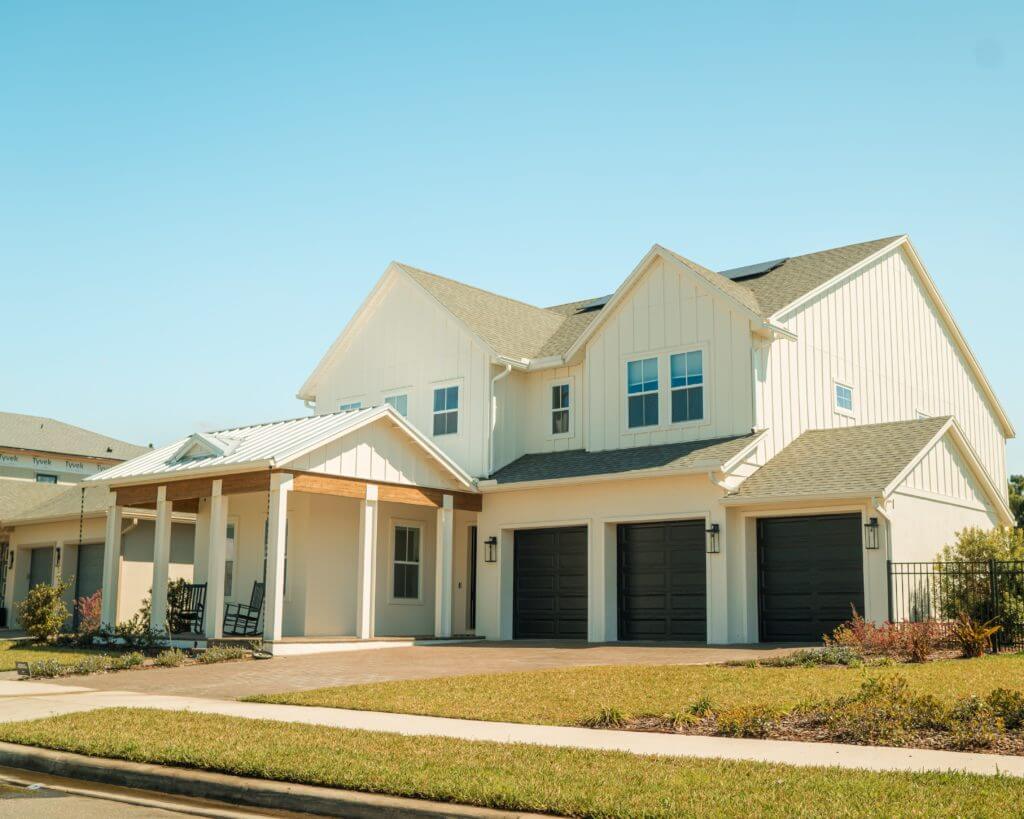
Is New House Siding a Good Investment?
Replacing your house siding can yield an 80% rate of return on your investment when you sell your home. If you’re looking to sell your home soon, new home siding is one of the best ways to increase your home’s curb appeal and potential buyer’s interest. High-quality siding types like stone siding or brick siding will increase your home’s value even more.
Even if you are planning to stay in your home for years, your new siding will increase the attractiveness of your home and make it more energy-efficient while you live there. Plus, most siding installations come with a lifetime warranty.
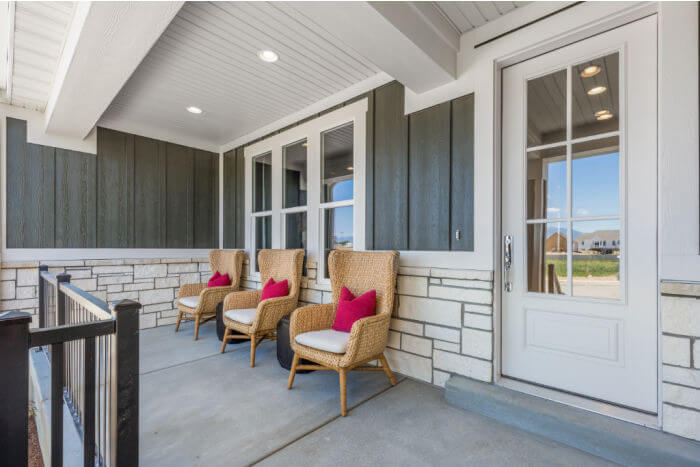
How to Find a Siding Replacement Professional
Finding a siding contractor you trust can be the most stressful part of the process. If you want to start finding contractors now, you can use our contractor directory to browse through the pros available in your area and request quotes. Modernize can also research for you. Click below to answer a few questions about your siding project, and we’ll match you with up to four pre-vetted contractors.
